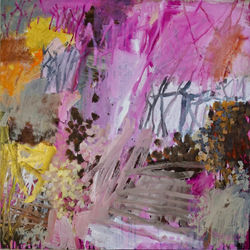 Maybe Rain, 2022 oil on linen 125 x 125 cm |  Nevermore, 2022 oil on linen 185.5 x 185.5 cm |
|---|---|
 Carpeted in Wildflower, 2022 oil on linen 170.5 x 185.5 cm |  Along the Way I, 2022 oil on linen 170 x 139.5 cm |
 Along the Way II oil on linen 170 x 139.5 cm |  Wee Jasper, 2022 oil on linen 173 x 173 cm |
 Micalong Creek, Wee Jasper, 2022 oil on board 92.5 x 92.5 cm |  A New Beginning, 2022 oil on board 92.5 x 92.5 cm |
 Howitt's Track I, 2022 oil on linen 142.5 x 142.5 cm |  Howitt's Track II, 2022 oil on linen 142.5 x 142.5 cm |
 Starlight, 2022 oil on linen 186 x 170.5 cm |  Long Plain, 2022 oil on linen 173 x 173 cm |
 Flooding Plains, 2022 oil on board 92.5 x 92.5 cm |  Pink Sky in the Morning, 2022 oil on board 92.5 x 92.5 cm |
 Faith, Hope and Sunshine, 2022 oil on board 92.5 x 92.5 cm |  Bushland Regeneration in Nitrogen Pink oil on Belgian linen 173 x 173 cm |
 First Light, 2022 oil on board 92.5 x 92.5 cm |  Tread Gently, 2022 Installation view Arthouse Gallery, Sydney |
 Tread Gently, 2022 Installation view Arthouse Gallery, Sydney |  Tread Gently, 2022 Installation view Arthouse Gallery, Sydney |
Tread Gently
Arthouse Gallery
2 - 23 April 2022
The paintings of Jo Davenport are an act of reverence, a soft yet enduring enunciation of the profundity of nature and its fortitude in an age of anthropogenic activities. Straddling a mid-point between recognition, of the landscape, and the sensed experience of it, Davenport’s works summon the ‘spirit’ of places from the artist’s personal history; specifically the Murray River region where she has resided for many years. Accumulated veils of paint in vivacious hues hatch a celebration of the natural world, yet beneath this benevolent veneer is a quiet lamentation for the tragic ecological realities of the Anthropocene. Hope, though, steers Davenport’s output as the artist looks optimistically toward a future where humanity reclaims its primordial connection to nature – seeing it not as extrinsic but as a vital part of ourselves; and of our survival. In her tender abstractions, gentle contemplations of the fragility of the landscape are tempered with maternal modalities of nurture, and of love.
Davenport’s newest series, ‘Tread Gently’, continues to reflect on the artist’s involvement with Earth Canvas – a pioneering project that couples six established artists with regenerative farmers in southern New South Wales. The realms of art and agriculture, here, are transcended by a shared vision of and affiliation with the land. Together, artists and farmers in the project have been looking for better ways not only to farm our land but to take care of our entire ecosystem. Partnered with farmers Nick and Dea Austin in the farming community of Mundarlo, Davenport cultivated intimate observations about changing relationships to the land at a time of accelerated climate change and heightened awareness of ecological ethics. The origin of these paintings, specifically, occurred when Davenport – along with a couple of friends – decided to escape the all-consuming forces of the pandemic, drought, bushfires and floods by immersing themselves in nature. Together they journeyed up to the High Plains around Kosciusko, travelling hundreds of kilometres through burnt-out forests and farming land. Along the way to Long Plain and Peppercorn Hill was a blanket of Alpine wildflowers – the first plants to regenerate after the fires – and as all the crowns of the trees were burnt, the landscape was enveloped in an endless floral carpet, pink and white and violet.
This sublime example of ecological succession, of renewal and resilience, has been translated into Davenport’s works via painterly performances of colour and mark, so full of life we can sense the flowers shimmering in the sun and holding tight to their precious patch of earth. Visceral swathes of oil thinly applied and poured create a sense of temporal layering. Primed with hope, each layer can be read as a stage of nature’s healing in its quest for stability. This layering, coupled with processes of stripping back and erasure, sees Davenport searching for forms as she goes, creating what she terms “a chain reaction, opening up new possibilities”. Her meandering linework, tectonic spaces and sections of dripped paint appear cartographic, pointing us towards an elusive future where the natural world has, perhaps, been restored.
Davenport’s signature abstraction is broken by moments of representation in these works – burnt-out trees stand like sentinels, while graceful wildflowers and native foliage emerge from within the constellations of marks. Some paintings are quiet, with veils of powder blue, pale grey and antique ivory singing sweetly of the fragility and beauty of the land. Others are louder, bolder, as vibrant pinks and yellows appear both defiant and joyous. A life-force surges within these compositions, as if each quivering stroke of oil hasn’t quite settled on the surface. And yet there is an anchoring sense of weight in the deep taupes and charred greys that carries the promise of endurance and resilience. Nature will persevere. In the artist’s varied palette we glimpse the elements – earth, wind, fire and water – which, combined on the canvas, create a vision of harmony, and restoration.
Davenport speaks of her immense desire to be quiet and listen to the changes in nature; “to feel the seasons, the time and the temperature of the day, watch the river flow and know that this view will never present exactly the same way again.” In and through her works, we are reminded, indeed, to tread gently on our planet; for it cannot be replaced.
Elli Walsh
Principle Writer, Artist Profile